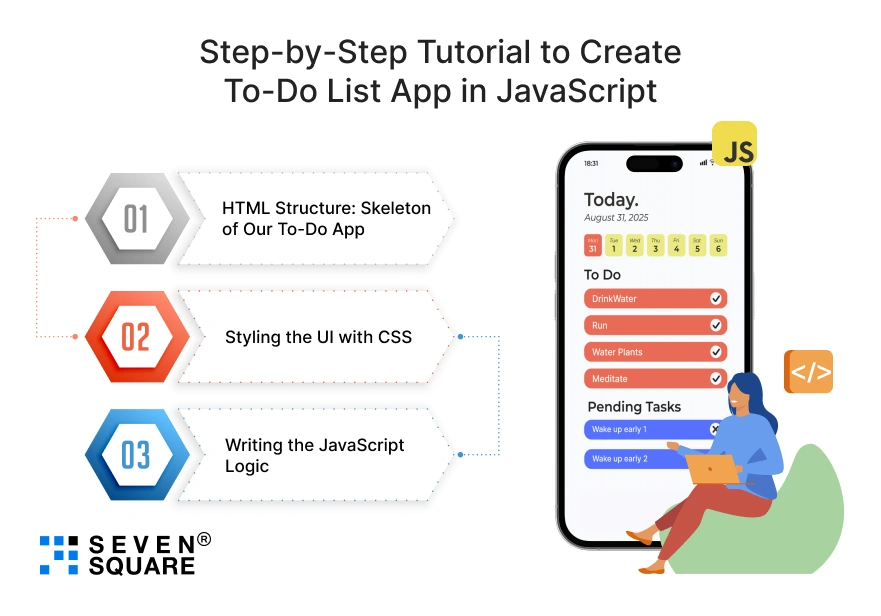If you’re looking to start with JavaScript app development, creating a To-Do List App in JavaScript is the perfect first step.
It’s one of the most practical, real-world apps you can build without depending upon any frameworks, just vanilla JavaScript.
Whether you’re organizing tasks, managing daily goals, or planning projects, a JavaScript To-Do List App helps demonstrate how you can build fully functional, interactive web apps with just HTML, CSS, and JavaScript.
Why it’s a perfect beginner-friendly project:
- Simple logic, yet powerful functionality.
- Teaches how to work with the DOM, events, and localStorage.
- Helps you understand how to structure real-life task manager apps.
By building this project, you’ll get hands-on experience with:
- DOM manipulation in vanilla JavaScript.
- Handling user events (clicks, keypresses).
- Saving tasks locally using localStorage.
- Creating a smooth, interactive UI from scratch.
So if you are trying to build To-do list app in JavaScript, then this blog is for you.
What You’ll Need Before You Start Building To-Do List App in JavaScript?
Before jumping into the code, here’s what you need to build your to-do list app using JavaScript:
- A basic understanding of HTML, CSS, and JavaScript.
- A code editor (like Visual Studio Code).
- Any modern browser (Chrome, Firefox, etc.) for testing.
- A GitHub account to version-control and share your project with the world.
No external libraries, no frameworks, just clean, Vanilla JS.
This makes the project lightweight, fast, and perfect for beginners and entrepreneurs looking for custom solutions.
What Are the Key Features We’ll Build in This App?
Your to-do list app will include practical features found in real-world productivity tools. Here’s what we’ll build, step by step:
- Add tasks dynamically using user input.
- Edit tasks on the go.
- Delete tasks with one click.
- Mark tasks as complete (and style them differently).
- Store and retrieve tasks using localStorage (so data isn’t lost on refresh).
- Create a responsive layout that works on both desktop and mobile.
- A clean, simple UI styled with basic CSS.
These features make the app both useful and impressive, which is perfect for client demos, product prototypes, or learning how modern JavaScript UI logic works.
Step-by-Step Tutorial to Create To-Do List App in JavaScript

Let’s now build this project from scratch using HTML, CSS, and vanilla JavaScript. Each step is explained so even beginners can follow easily.
Step 1: HTML Structure: Skeleton of Our To-Do App
Start with the base layout. This HTML sets up the input, add button, and task list container.
<!DOCTYPE html>
<html lang="en">
<head>
<meta charset="UTF-8">
<meta name="viewport" content="width=device-width, initial-scale=1.0">
<title>To-Do List App in JavaScript</title>
<link rel="stylesheet" href="style.css">
</head>
<body>
<div class="todo-container">
<h1>My To-Do List</h1>
<div class="input-group">
<input type="text" id="task-input" placeholder="Add a new task..." />
<button id="add-task-btn">Add</button>
</div>
<ul id="task-list"></ul>
</div>
<script src="script.js"></script>
</body>
</html>
Step 2: Styling the UI with CSS
Here’s the CSS for a simple responsive design and visual feedback for completed tasks.
/* style.css */
/* Global Styles */
body {
font-family: 'Segoe UI', sans-serif;
background-color: #f2f2f2;
padding: 20px;
display: flex;
justify-content: center;
align-items: flex-start;
min-height: 100vh;
}
/* Container */
.todo-container {
width: 100%;
max-width: 500px;
margin: auto;
background-color: #fff;
padding: 20px;
border-radius: 12px;
box-shadow: 0 2px 10px rgba(0, 0, 0, 0.1);
}
/* Heading */
.todo-container h1 {
text-align: center;
margin-bottom: 20px;
color: #333;
}
/* Input Section */
.input-group {
display: flex;
gap: 10px;
margin-bottom: 20px;
}
#task-input {
flex: 1;
padding: 10px;
border-radius: 6px;
border: 1px solid #ccc;
font-size: 16px;
}
#add-task-btn {
padding: 10px 16px;
background-color: #007BFF;
color: #fff;
border: none;
border-radius: 6px;
font-size: 16px;
cursor: pointer;
transition: background 0.3s;
}
#add-task-btn:hover {
background-color: #0056b3;
}
/* Task List */
#task-list {
list-style: none;
padding: 0;
}
#task-list li {
display: flex;
justify-content: space-between;
align-items: center;
background: #f9f9f9;
padding: 10px 15px;
border-radius: 6px;
margin-bottom: 10px;
transition: background 0.3s;
}
/* Completed Task */
#task-list li.completed {
text-decoration: line-through;
color: gray;
background-color: #e6e6e6;
}
/* Task Action Buttons */
.task-buttons {
display: flex;
gap: 6px;
}
.task-buttons button {
background: none;
border: none;
cursor: pointer;
color: #007BFF;
font-size: 16px;
transition: color 0.2s;
}
.task-buttons button:hover {
color: #0056b3;
}
/* Responsive Design */
@media (max-width: 600px) {
.todo-container {
padding: 15px;
}
.input-group {
flex-direction: column;
}
#add-task-btn {
width: 100%;
}
#task-list li {
flex-direction: column;
align-items: flex-start;
}
.task-buttons {
margin-top: 8px;
}
}
Step 3: Writing the JavaScript Logic
This JavaScript code will handle user input, dynamic DOM creation, and localStorage handling for a fully functional to-do list.
// script.js
const taskInput = document.getElementById('task-input');
const addTaskBtn = document.getElementById('add-task-btn');
const taskList = document.getElementById('task-list');
let tasks = JSON.parse(localStorage.getItem('tasks')) || [];
function saveTasks() {
localStorage.setItem('tasks', JSON.stringify(tasks));
}
function renderTasks() {
taskList.innerHTML = '';
tasks.forEach((task, index) => {
const li = document.createElement('li');
if (task.completed) li.classList.add('completed');
li.innerHTML = `
<span onclick="toggleComplete(${index})">${task.text}</span>
<div class="task-buttons">
<button onclick="deleteTask(${index})">❌</button>
</div>
`;
taskList.appendChild(li);
});
}
function addTask() {
const taskText = taskInput.value.trim();
if (taskText !== '') {
tasks.push({ text: taskText, completed: false });
taskInput.value = '';
saveTasks();
renderTasks();
}
}
function deleteTask(index) {
tasks.splice(index, 1);
saveTasks();
renderTasks();
}
function toggleComplete(index) {
tasks[index].completed = !tasks[index].completed;
saveTasks();
renderTasks();
}
addTaskBtn.addEventListener('click', addTask);
window.addEventListener('load', renderTasks);
Explore the full open-source JavaScript to-do list code from GitHub.
What Are the Extra Features to Try? (Level Up Your Project)
Once you’ve built the core features, you can take your JavaScript to-do list project to the next level by adding:
- Task categories or priority labels (high, medium, low).
- Drag-and-drop sorting using JavaScript or a library.
- Due dates, reminders, or alerts using setTimeout or browser notifications.
- Dark mode toggle for better user experience.
- Firebase or backend integration to make your to-do app cloud-based.
These advanced additions show that you’re not just following tutorials, you’re solving real problems with modern web technologies.
Why Do Businesses Trust Us for JavaScript Projects?

We create fully functional web applications using the latest JavaScript technologies.
Whether you’re building a vanilla JavaScript to-do list app, a full-stack SaaS platform, or a real-time dashboard, we’ve got you covered.
- Experts in Vanilla JavaScript, React, Node.js, and More: From beginner-level JavaScript projects like a to-do list app to enterprise-grade applications, our team delivers robust, scalable code.
- Custom App Development: We specialize in creating personalized solutions using lightweight stacks like HTML, CSS, and JavaScript, which is perfect for MVPs and product launches.
- Performance-Focused UI/UX: Our front-end developers create responsive, and mobile-friendly interfaces that perform beautifully across all devices.
- LocalStorage, Firebase & API Integration Experts: Whether you’re storing to-do tasks in localStorage or syncing data with a backend API, we ensure data persistence and app stability.
Want a JavaScript App? Contact Us Today!
Start Small, Build Big
Looking to build your first web app? This vanilla JavaScript to-do list tutorial is the best opportunity for you.
Now you’ve learned how to:
- Build a responsive, functional task manager.
- Use JavaScript DOM manipulation and localStorage.
- Download and customize open-source GitHub code.
- Upgrade your project with advanced features.
FAQs
- Yes, you can build a fully functional to-do list app using vanilla JavaScript, along with basic HTML and CSS.
- No frameworks like React or Vue are required for this beginner-friendly JavaScript project.
- You can use localStorage in JavaScript to store tasks in the user’s browser.
- It’s simple, fast, and doesn’t require any database setup, making it perfect for personal or prototype apps.
- Use CSS media queries and flexbox/grid layouts to make your to-do list app layout responsive.
- This ensures the app looks great on both desktop and mobile devices.
- Yes, this vanilla JavaScript app is easily extendable.
- You can add dark mode, task priority levels, due dates, or even integrate Firebase for real-time data storage.